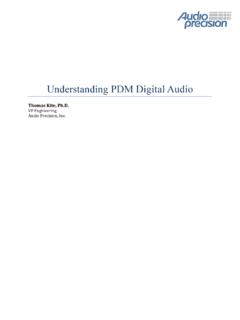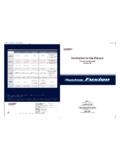Transcription of Digital Audio Filter - NTHU - CVLab
1 CS 3570. Chapter 5. Digital Audio Processing Part II. Sec. CS 3570. Digital Audio Filter A Digital Audio Filter is a linear system that changes the amplitude or phase of one or more frequency components of an Audio signal. Types of Digital Audio Filter FIR (finite-impulse response) Filter IIR (infinite-impulse response) Filter 2. CS 3570. FIR Filter . 3. CS 3570. IIR Filter The infinite form of the IIR Filter function is defined by However, Finding the values h(n) for an infinitely long mask is impossible. The equation can be transformed to a more manageable difference equation form. 4. CS 3570. IIR Filter . 5. CS 3570. Impulse and Frequency Response The convolution mask h(n) for an FIR or IIR Filter is sometimes referred to as the impulse response. The frequency response, H(z), represents h(n) in frequency domain.
2 A frequency response graph describes how a Filter acts on an Audio signal. 6. CS 3570. Filters and Related Tools in Audio Processing Software band filters low-pass Filter retains only frequencies below a given level. high-pass Filter retains only frequencies above a given level. bandpass Filter retains only frequencies within a given band. bandstop Filter eliminates all frequencies within a given band. convolution filters FIR filters that can be used to add an acoustical environment to a sound file for example, mimicking the reverberations of a concert hall. 7. CS 3570. Filters and Related Tools in Audio Processing Software comb filters add delayed versions of a wave to itself, resulting in phase cancellations that can be perceived as echo. Phase cancellations eliminate frequency components when two sine waves that are out-of- phase with each other are summed.
3 Thus, the frequency response has the shape of a comb. Frequency response of a comb Filter 8. CS 3570. Filters and Related Tools in Audio Processing Software graphic equalizer gives a graphical view that allows you to adjust the gain of frequencies within an array of bands. parametric equalizer similar to a graphic equalizer but with control over the width of frequency bands relative to their location. 9. CS 3570. Equalization Equalization (EQ) is the process of selectively boosting or cutting certain frequency components in an Audio signal. EQ tools Shelving Filter Graphic equalizer Parametric EQ. 10. CS 3570. Shelving Filter Low-shelf High-shelf Boosting Cutting 11. CS 3570. Graphic Equalizer A graphic equalizer divides the frequency spectrum into bands and allows you to control the amplitude for these bands individually.
4 12. CS 3570. Parametric EQ. A parametric EQ is more flexible for equalization in that it allows you to focus on individual bands of frequencies. You can set the center point of a band and its bandwidth and adjust the frequencies in this band as you desire. Parametric EQs are based on bandpass and bandstop filters. This type of Filter is sometimes called a peaking Filter . Peaking Filter 13. CS 3570. Parametric EQ. Q-factor(quality factor): determines how steep and wide the peaking curve is. The higher the Q, the steeper the peak of the band. 14. CS 3570. Relationship Between Convolution and Fourier Transform . Equivalent operations in time and frequency domains 15. CS 3570. FIR Filter Design The following section introduces a simple method to design your own filters. 16. CS 3570. FIR Filter Design Terms The convolution mask h(n) is also called the impulse response, representing a Filter in the time domain.
5 Its counterpart in the frequency domain, the frequency response H(z), is also sometimes referred to as the transfer function. A frequency response graph can be used to show the desired frequency response of a Filter you are designing. 17. CS 3570. FIR Filter Design Ideal Filter An ideal low-pass frequency response graph, normalized. In the graph, angular frequency is on the horizontal axis. The vertical axis represents the fraction of each frequency component to be permitted in the filtered signal. The cutoff frequency c must be less than .(Nyquist theorem). Figure 18. CS 3570. FIR Filter Design Ideal Filter The frequency response graph shown in Figure is an example of a rectangle function. If it is an idealized form of H(z), then what would be the corresponding ideal impulse response, an idealized h(n)?
6 The inverse Fourier transform of a rectangle function in the frequency domain is a sinc function in the time domain(Derivation on textbook ). 19. CS 3570. FIR Filter Design Ideal Filter 20. CS 3570. FIR Filter Design Ideal to Real A sinc function goes on infinitely in the positive and negative directions how can we implement an FIR. Filter ? One way is to multiply the ideal impulse response by a windowing function. The purpose of the windowing function is to make the impulse response finite. However, making the impulse response finite results in a frequency response that is less than ideal, containing ripples . 21. CS 3570. FIR Filter Design - Realistic The passband corresponds to the frequencies the Filter tries to retain. The stopband corresponds to the frequencies the Filter attenuates or filters out.
7 In a real Filter , a transition band lies between passband and stopband, and the slope is not infinitely steep, as in an ideal Filter . Frequency response of a realistic low-pass Filter 22. CS 3570. FIR Filter Design Windowing Function . 23. CS 3570. FIR Filter Design - Algorithm /*Input: f_c, the cutoff frequency for the lowpass Filter , in Hz f_samp, the sampling frequency of the Audio signal to be filtered, in Hz N, the order of the Filter ; assume N is odd Output: a low-pass FIR Filter in the form of an N-element array */. /*Normalize f_c and _c so that is equal to the Nyquist angular frequency*/. f_c = f_c/f_samp _c = 2* *f_c middle = N/2 /*Integer division, dropping remainder*/. /*Create the Filter using the low-pass Filter function from Table */. /*Put a dummy value in for n = 0 to avoid a divide by 0 error)*/.
8 For n = N/2 to N/2. if (n = 0) fltr(middle) = 1. else fltr(n + middle) = sin(2* *f_c*n)/( *n). fltr(middle) = 2*f_c /*Multiply the elements of fltr by a windowing function chosen from Table We use the Hanning window function */. for n = 0 to N-1. fltr(n) = fltr(n) * ( + *cos((2* *n)/N)). 24. CS 3570. Digital Audio Compression Time-Based Compression Methods No need to transform the data into frequency domain. A-law encoding, -law encoding(Ch4) etc. These methods are often considered conversion techniques rather than compression methods. The most effective Audio compression methods require some information about the frequency spectrum of the Audio signal. These compression methods are based on psychoacoustical modeling and perceptual encoding. 25. CS 3570. Psychoacoustics Psychoacoustics ( ).
9 The study of subjective human perception of sounds. The study of all the psychological interactions between humans and the world of sound. Psychoacoustical tests have shown that there is a great deal of nonlinearity in human sound perception. The octave from middle C (called C4) to C5 ranges from Hz to Hz, while C5 to C6 ranges from to Hz. But the distance from C4 to C5. subjectively sounds the same as the distance from C5 to C6. 26. CS 3570. Psychoacoustics Humans hear best in the 1000 to 5000 Hz range, the frequency range of human speech. For a 100Hz and 1000Hz tone, the 100Hz tone need larger amplitude to sound equally loud as the 1000Hz. Similarly, For a 10000Hz and 1000Hz tone, the 10000Hz tone need larger amplitude to sound equally loud as the 1000Hz. 27. CS 3570. Psychoacoustics At low frequencies, we can distinguish between sound waves that are only a few Hz apart.
10 At high frequencies, the frequencies must be a hundred or more Hz apart for us to hear the difference. The reason is that the ear is divided into frequency bands called critical bands. Human ear perceive different frequencies by the response of different critical bands. Critical bands are narrower for low- than for high- frequency sounds. Between 1 and 500 Hz, bands are about 100 Hz in width. The critical band at the highest audible frequency is over 4000 Hz wide. 28. CS 3570. Psychoacoustics Masking - Within a small window of time, the loudest frequency sound can overpower the others in the critical band, making human unable to hear the other frequencies. 29. CS 3570. A Sketch of Compression A small window of time called a frame is moved across a sound file. In each frame, use different filters to divide the frame into bands of different frequencies.






